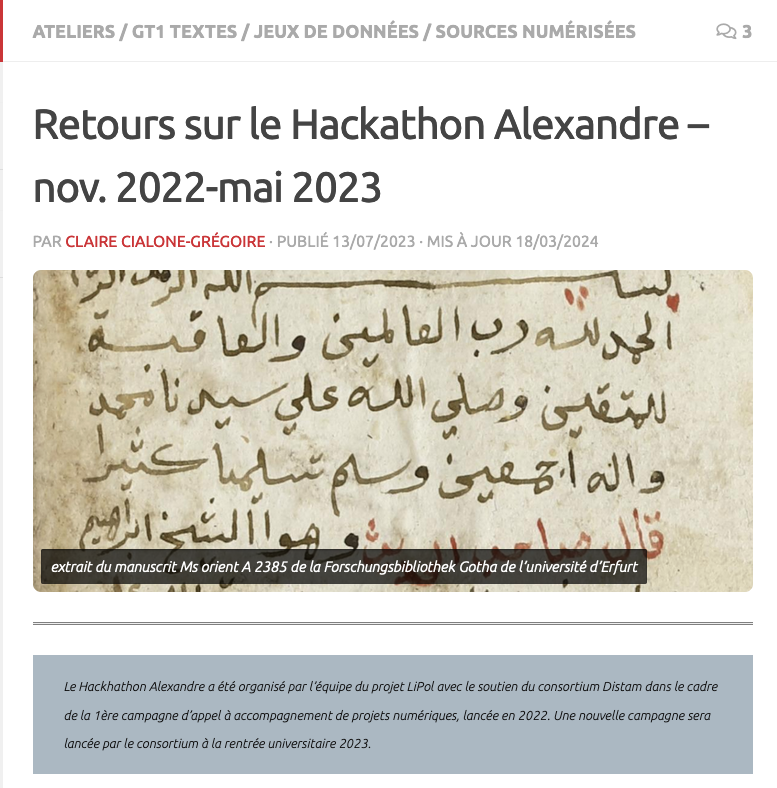Since 2022, DISTAM (DIgital STudies Africa, Asia, Middle East) has been a consortium of the French research infrastructure Huma-Num. It is intended to accompany and consolidate the digital transition of Middle Eastern, African, and Asian studies in France. The Huma-Num Consortiums, which cover twelve various fields, define shared digital procedures and standards (methods, tools, sharing of experience). One of their characteristics is that they bring together professionals with different and complementary skills: humanities researchers, computer scientists, and librarians. They have been accredited for a period of four years, renewable once. Among them, DISTAM is the only consortium having an areal dimension. It was presented in June 2022 during the DO conference (see the abstract here)
The DISTAM consortium is interested in languages with non-Latin scripts (Arabic, Chinese, Hebrew, Ethiopic, etc.), which have been digitised less through OCR and Handwritten Text Recognition (HTR), and for which text mining still remains poorly or insufficiently developed. It also specifically aims to support researchers facing increasingly inaccessible fieldwork, which is particularly the case nowadays in Africa and in the Middle East. Finally, the consortium aims to address the issue of low-cost digitisation policies and DH in the contexts with poor or irregular access to internet and electricity. This challenges our Western standards and practices and calls for a more low-tech approach – which is also a good and virtuous approach, whether it is imposed by infrastructures and budgets or by ecological motivations.

DISTAM brings together some 30 academic structures of various kinds working in the area of African studies, Asian Studies, and Middle East and Muslim Worlds studies (research laboratories in France and abroad, libraries, and a start-up) and will soon be joined by several others. It is composed of four working groups, each focusing on a theme related to the digital humanities. Working Group 1 (Texts) is concerned with the encoding, publication, and text-mining of textual corpora written in non-Latin scripts. Working Group 2 (Web Archiving) explores issues related to web resources, their analysis and preservation, and responds to a growing demand for work on sensitive or now inaccessible fieldwork. Working Group 3 (Maps and Images) specialises in issues of spatialisation and data visualisation. Finally, Working Group 4 (Ethical and Legal Issues) is committed to laying the foundations for a solid reflection on the ethical issues of research related to cultural areas.
The productions and the events organised by these working groups vary: seminars, workshops, guides, …. They take on many forms. In addition, every year since 2022, the DISTAM consortium has organised a summer school, an opportunity to meet for a week around common themes and to gradually create a community of PhD students, senior researchers, engineers, and librarians. The diversity of profiles, both in terms of technical competences and field of research, of researchers sharing the same interest for digital tools and epistemological questions is really inspiring! By the way, Cornelis van Lit – founder of DO if ever it is necessary to recall it! – gave the opening speech during 2022’s conference, and this motivated me to become a regular contributor to DO ever since. The next one will take place in July 2024, see the beautiful program here.

Boost funding is offered to (not only) young researchers to carry out a very specific aspect of a DH project and often to complete it. The consortium offers methodological and financial support to applicants who wish to fairise their data, acquire specific skills for their projects or seek technological support. Projects must be part of an open science framework in line with the FAIR principles, and to date more than a dozen projects have received modest but effective support, such as for those already accessible online:
Projet HiRAda-Himalayan Rock Art by Laurianne Bruneau (CRCAO) for the work on indexing using the OpenTheso tool;
the migration and stabilisation of the results of the CairMod project, with the publication of all the data in open access (date in the Nakala repository, database done with Heurist), a user-friendly website and documentation of the migration process;

a hackathon to acquire the text of Arabic manuscripts in order to prepare ground-truth data for the HTR of the corpus.

The scientific blog of the Huma-Num DISTAM consortium aims to serve as a reference and working space for the development of digital humanities applied to area studies. It is intended for researchers, research IT, and librarians alike. The aim is to facilitate access to reference resources in digital humanities, whether it is digitised resources, datasets, tools, tutorial, conferences and seminars, a bibliography generated by a collective group on Zotero, and so on. It is also important to reflect on the ethical and legal issues related to digital data and metadata in one’s field of specialisation. A monthly newsletter accompanies this effort to publicise digital humanities activities in area studies.
